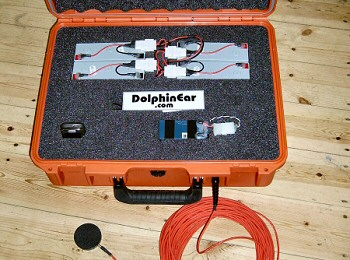Wireless Ready

Above: Custom DE600 ready for 6 week deployment in remote Iceland to monitor glascial melting to gather Climate Change data.
DE-
NEW –
WHAT IS IT?
DolphinEar ‘600’ WIRELESS (DE600) is a combination of hydrophone, pre-
The DE600 is available in a number of forms: as a wireless ready module that you can build into your radio or telephone equipment, or as a custom instrument (as shown in the photo) that we can build to your own specifications. The mobile telephone version has built in compensation which helps to compensate for narrowness of the normal telephone bandwidth.
WHY DO YOU NEED IT?

Inside view showing batteries (gray-top) needed to operate the mobile phone (black object-lower left) and a smaller battery (blue object) that powered the DE600 (white object-center). The hydrophone is attached to a waterproof connector near the handle..
‘DE600’ lets you monitor underwater sounds from a wide geographic locations from your desk or lab. You can conduct bio-
Your LISTENING POST
One advantage of using DE600 wireless hydrophones is that you can concentrate your analysis equipment in one location. Audio streams can be connected directly from your telephone to your computer for storage on your hard disk. Real time analysis is possible with many standard sound software. We include a copy of spectrogram software with the DE600 package that lets you watch sounds as they come in from the remote site. If you have a multi-
USE WITH RADIOS
While we are emphasizing the use of mobile cellular telephones, the DE600 can also be connected to a VHF or UHF radio system. While the range will be limited to line-
USE WITH MOBILE TELEPHONES

Deploying one of the DE600 Wireless units at a glacial lake in Iceland. An ordinary Mobile telephone allowed people in 130 countries to direct dial and hear a melting glacier in winter.
Mobile telephone impose bandwidth limitations that at first glance seem like major limitations. This is NOT the case in reality. Virtually all of the important long distance sound monitoring done with hydrophones occurs at frequencies below 3000 Hz. The DE600 with it’s audio preprocessing system provide an end-
MOBILE TELEPHONE COVERAGE
Mobile telephone coverage has increased tremendously over the past decade. Coverage in remote parts of the world are possible in areas that have no regular landline service. Even in offshore applications there are many places in the world where great range can be obtained. For example, we achieved good communications with a mobile telephone 75 miles off the coast of New Zealand. Range depends greatly on the placement of the mobile telephone node as well as it’s height above sea level. But, large areas of the world are now covered by mobile networks. If you can get a signal at the desired location, then you can use the DE600. In other areas connection to satellite telephones are possible making this a truly global monitoring system –
For the Iceland glacial project, The DE600 and it’s mobile telephone had to operate for the entire duration of the project – 60 days. There was no one there to charge batteries, or dust snow and ice off the equipment. Temperatures warmed to -10C but winds peaked at around 45 knots at times. It’s not a place you want to visit to fix broken equipment! We made sure there was enough battery capacity to last for a minimum of 90 days at -25 degrees Celsius! Once closed, the entire apparatus was watertight.
LISTEN TO SAMPLES
To hear what you can expect from the DE600 system, have a look at our DE600 SAMPLES section here. We present typical sounds from whales, dolphins (including echo location clicks), fish, boats, and other sounds that have been reduced in bandwidth (20-
TYPICAL USES
Have a look at some typical uses here and here.
AVAILABILITY
While this is not ordinarily an off-
